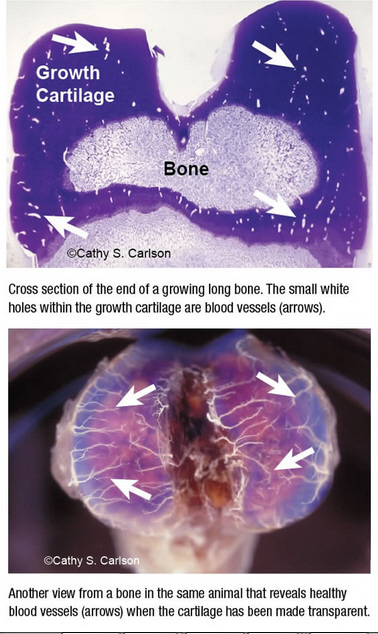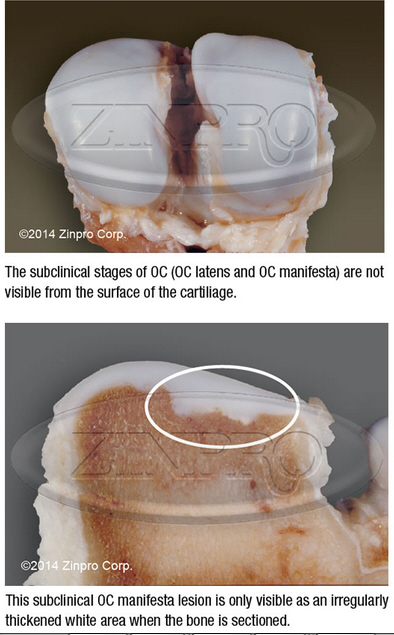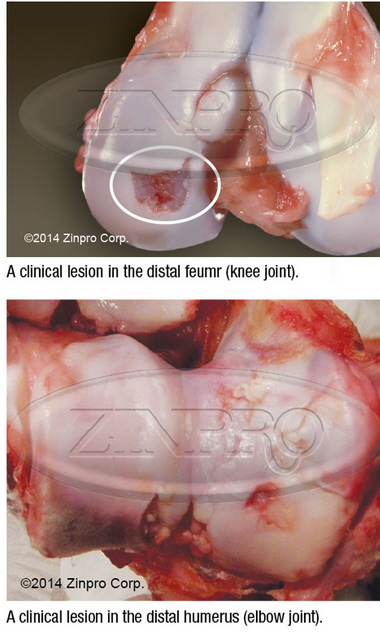



Silent Disease Leads to Lameness and Lost Production
Osteochondrosis affects pigs as early as one month of age and the threat continues up to five months of age, making it a critical factor in gilt development, according to Zinpro.Swine lameness has many causes, but perhaps one of the most common — yet least understood — is osteochondrosis (OC). The disease is considered the leading cause of lameness and secondary joint disease in swine, according to Cathy S. Carlson, DVM, PhD, University of Minnesota.

The condition develops as growth cartilage in the young pig begins to be replaced by bone (Figure 1). OC affects pigs as early as one month of age and the threat continues up to five months of age, making it a critical factor in gilt development.
The cost of OC to swine producers is linked to slower growth, higher mortality and loss of productivity. According to John Deen, DVM, PhD, University of Minnesota, the average loss for finishing pigs associated with lameness is US$23 per head, while a diagnosis of lameness in the sow herd translates into a loss of $200 to $300 per sow.
In the early 1970s, OC was recognised as an important component of lameness in commercial swine operations and confinement systems as pigs were pushed for rapid growth. Research on OC began in Scandinavia more than 40 years ago where leg weakness proved to be an economic issue. OC is also a significant problem in horses and large breed dogs.

Exploring OC Development
OC is a disorder of epiphyseal (or growth) cartilage that is located at the end of long bones (articular-epiphyseal cartilage complex), as well as in the growth plate. The disease occurs in highly predictable sites, primarily the ends of the humerus, ulna and femur with lesions frequently found bilaterally.
In young pigs, the growth cartilage has an abundant blood supply. As the pig matures, the cartilage is gradually replaced by bone. However, when blood flow is restricted to growing cartilage, the cartilage dies, forming one of two types of subclinical lesions (Figure 2):
- OC latens — only visible microscopically
- OC manifesta — visible in gross examination or radiographically (x-ray)

Neither OC latens nor OC manifesta results in lameness and both often heal completely as the pig grows.
The prevalence of subclinical OC lesions in commercial swine operations is estimated to be more than 70 per cent.
Dr Carlson said: “While subclinical lesions are quite common, a large portion of these lesions heal completely. In these cases, bone is able to form around areas of dead cartilage and complete the healing process.”
However, if the dead cartilage collapses under the pressure of bearing weight, clinical OC develops, often resulting in lameness and pain. The clinical lesion (Figure 3) is one in which a cleft forms through the dead cartilage to the cartilage surface known as OC dissecans (OCD).
According to Dr Carlson, the exact cause of the failure to supply blood to cartilage that results in chondrocyte (cartilage cell) death is unknown. However, trauma due to management or environmental factors can cause a subclinical lesion to progress into a clinical lesion resulting in OCD.

Trauma to the bone surface causes a cleft formation within the necrotic and soft cartilage beneath the overlying normal articular cartilage at the weight-bearing surfaces. This leads to inflammation of the synovial membrane, increased joint fluid and clinical signs of lameness.
Dr Carlson explained: “Once the cartilage cleft is formed, the disease proceeds down a ‘path of no return’ resulting in pain and creating a welfare issue for the animal.
“Although we’ve been studying OC for more than four decades, we don’t have a clear-cut solution to the disease.”
One of the factors slowing research into the disease is that until very recently, the process and results of the condition could not be visualised. Advanced imaging techniques available today did not exist. Instead, animals had to be examined using histological techniques.
Dr Carlson added: “We do know that OC occurs primarily in the medial aspect and the sagittal ridge of the distal end of the humerus and the medial condyle of the femur, as well as the distal ulnar physis (growth plate).” (Figure 4).

According to the Minnesota veterinarian, new research studies utilising whole-pig scans hold promise for improved insight into OC development. The whole-pig scan technology will also allow researchers to more effectively study the effect of genetics, handling scenarios and feeding studies on managing the disease.
Prevention Measures
Although OC first emerged as pigs were being bred and fed to gain weight faster, growth rate alone is not causative for OC. Rather, it is the anatomical structure found in body conformation and joints associated with these fast-growing animals that is the stronger link to OC.
Norwegians conducted one of the earliest studies looking at the effects of conformation on the development of OC in swine. This study followed the development of the disease over several generations and also included a scoring system for OC.
Dr Carlson reported: “Through these studies, Norwegian researchers found a genetic link to OC through the boar line. They were able to substantially decrease the prevalence of OC through careful breeding selection.”
While research continues, several simple management steps can help prevent the formation of lesions found in the clinical form of OC. These preventive measures for pigs from 11kg (24.2 lb) to 60kg (132.3 lb) include:
- providing softer bedding
- decreasing or eliminating transportation
- reducing steps and obstacles in the environment
- avoiding mixing events that lead to increased fighting.
Dr Carlson urges swine producers to pay particular attention to the handling of replacement gilts.
She said: “We know that osteoarthritis can result as a secondary chronic issue in pigs that experienced OC during growth. Sows have an extended life cycle in the herd while carrying more weight throughout their productive life. These two factors predispose sows to osteoarthritis.”
For more information, contact your Zinpro Performance Minerals representative or visit the web site, www.zinpro.com/.
Feet First® Update is a publication produced by Zinpro Corporation and the Feet First Team, an international collaboration of researchers, veterinarians and nutritionists. The Feet First programme focuses on swine welfare and helping improve the efficiency of pork production through the identification and prevention of lameness.
April 2014








